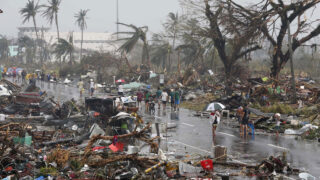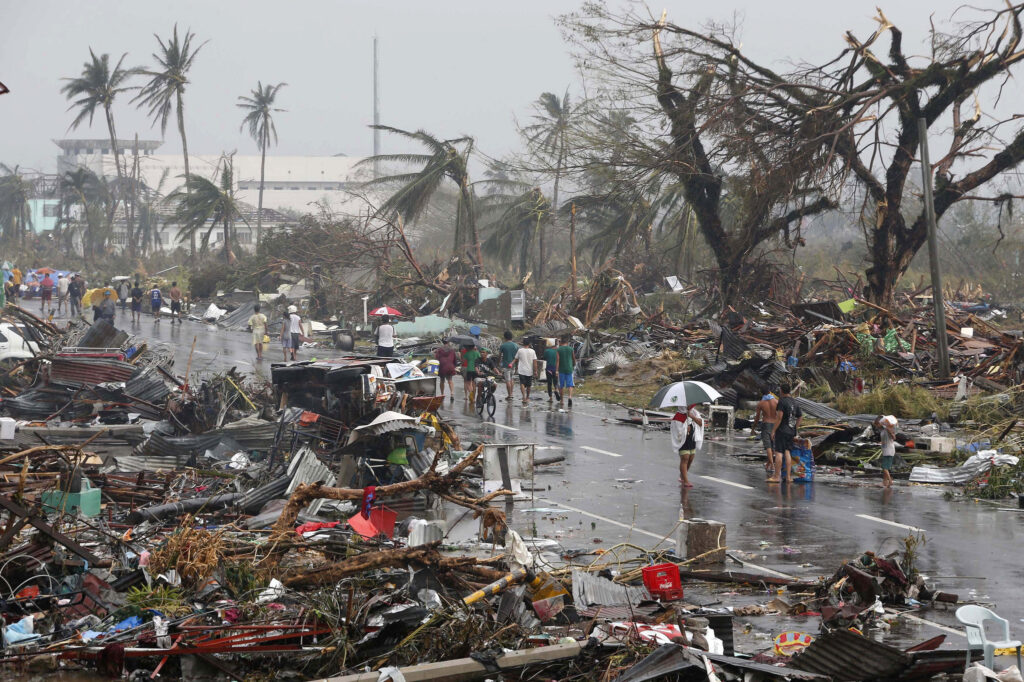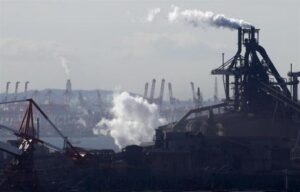こんにちは。京都事務所インターンのマーヴィンです。
気候変動の影響と途上国
社会的にも、技術的にも、資金的にも、気候変動に適応するための資源に乏しい途上国は、気候変動に対して最も脆弱な国々だとされています。
気候変動に関する政府間パネル(IPCC)の最新の報告書によると、気候変動の影響は特に途上国において、貧困を悪化させ、人間開発(human development)*1を妨げると予測されています。
*1訳注:「人間開発が扱うのは国民所得の増減に留まりません。人間開発とは、人々が各自の可能性を十全に開花させ、それぞれの必要と関心に応じて生産的かつ創造的な人生を開拓できるような環境を創出することです」(出典:UNDP「人間開発とは」)
IPCCは国連機関によって設置された政府間機関であり、
IPCCの予測では、気候変動は、経済成長の鈍化、貧困削減の困難化、食料安全保障に脅威をもたらすばかりか、すでにある貧困を長引かせるとともに、新たな貧困を生み出しさえします。気温上昇は農作物の生産量減少や、特に農業経済に対する飢餓のリスクの増大、水不足といった深刻な影響を引き起こすでしょう。それはまた、食や水が安全でないために健康リスクの増加や、マラリアといった気候の変化の影響を受けやすい病気が広まるリスクをも増大させます。
このように、このように、気候変動は、農家や、
レジリエンス(回復力)の構築
~気候脆弱性フォーラム~
気候変動の脅威が増し、行動が必要になったことに応じて、気候変動に対して非常に脆弱な国々は、「気候脆弱性フォーラム(CVF)」を結成しました。CVFは、地球規模の気候変動に対処するために共に行動する、南南協力のためのプラットフォームとして提供される国際パートナーシップです。CVFは専門知識や経験を共有することを目的に、アジアやアフリカ、ラテンアメリカの途上国から構成されています。
2009年モルディブでの気候脆弱性フォーラムの第一宣言では、参加する21カ国が「我々の国々は気候変動の最前線におり、温暖化の影響を他地域より顕著に受ける」という声明を出しました。
CVFには、アフガニスタンやバングラディッシュ、バルバドス、ブータン、コスタリカ、エチオピア、ガーナ、キリバス、マダガスカル、モルディブ、ネパール、フィリピン、ルワンダ、セントルシア、タンザニア、東ティモール、ツバル、バヌアツ、ベトナムといった国が参加しています。
もし気候変動が3~4℃の地球温暖化への経路をたどるのであれば、これらの地域は人為起源の気候変動による最悪の影響に苦しむことになるでしょう。
気温の上昇と海水温上昇によって、年間の降水量がより極端になります。
降水量にむらが出ることで、東アフリカでは亜熱帯の乾燥地や半乾燥地が干上がると予測され、また極端に降水量が多くなることで南アジア(たとえばネパールやバングラディッシュ、インド)や東南アジア(たとえばミャンマーやタイ、フィリピン)でより強力なサイクロンが発生し、東アジアではモンスーンがより強くなる可能性があります。
実際、このような現象はもはやニュースではなく、我々や他の多くの途上国にとって厳しい現実なのです。
前代未聞の災害~台風ハイエン~
2013年11月、観測史上最も強力な台風ハイエンが上陸し、フィリピンで猛威をふるいました。台風による集中豪雨や暴風や大波は壊滅的な被害をもたらしました。それは街を壊滅させ、
台風ハイエンの生存者から成る団体であるピープル・サージは、自分たちが辛くも生き延びた話を語り伝えようとしています。台風の生存者の多くは全てを失い、家族はたがいに離れ離れになり、もはや家と呼べるものが何もありません。農民や漁師、労働者や都市の貧困者、低賃金労働者は、気候災害によってさらなる貧困へと追いやられていくのです。
ピープル・サージによると、多くの人々にはいまだに土地がなく、仕事がなく、公共サービスを受けることができず、布で作った住処や掘っ立て小屋に住んでいるといいます。台風の襲来から1年経ちましたが、復興・再生は遅々として進んでいません。救援活動が包括的に行われていないため、雇用や生活の手段がないことは、今でも大きな問題です。
フィリピン政府はすでに多大な努力を費やしていますが、
アフリカにおける不安定な食糧供給
アフリカでは、
国際農業研究協議グループ(CGIAR)によると、少し気候が変わるだけで、農家は深刻な影響を受けてきました。予想外の異常な豪雨が発生すれば、十分な計画が立てられなくなり、農作物生産量の減少につながります。
農業に依存した経済において、
小さな気候の変動もこれらの国々では人々と社会の発展に甚大な影響を及ぼすのです。
食料供給が不安定になるせいで、
南アジアへの影響
CGIARは、高い人口増加率と貧困のため、南アジアは気候変動に脆弱な状況に陥るだろうと指摘しています。
南アジアの経済は農業に強く依存しています。気候変動が進めば、干ばつの増加や、かつてないほどの洪水、熱波、そして農業生産量の減少に直面することになりかねません。
一方、低地は洪水で浸水する可能性がより高くなります。カルカッタやムンバイ、ダッカといったインドの都市部には4600万人が生活していますが、大規模な浸水の危険性があります。
バングラデシュは低地に位置しており、洪水やインド洋のサイクロンに対して非常に脆弱です。1991年には6メートルの高さの津波により約14万人の人が亡
気候変動対策を広く普及して社会的な優先順位を引き上げるため、
気候変動への大規模な適応
国連気候変動枠組条約(UNFCCC)は、
現在の資金支援は十分ではありません。裕福な国も貧しい国も気候変動に適応する必要があり、それには多くの費用がかかるでしょう。しかしながら、
技術移転や能力開発、リスク共有といった、
しかし、合意や国際協力が実現しなければ、気候変動と闘うための歩みが止まってしまうでしょう。
 本記事の執筆者のマーヴィン・トレス・ラゴネラは、気候ネットワークのインターンです。フィリピンのアテネオ・デ・マニラ大学で修士を取得し、ASEAN大学ネットワークと京都大学間の交流プログラムのもと京都大学でエネルギー管理と持続可能性の転換に関する研究に従事しました。
本記事の執筆者のマーヴィン・トレス・ラゴネラは、気候ネットワークのインターンです。フィリピンのアテネオ・デ・マニラ大学で修士を取得し、ASEAN大学ネットワークと京都大学間の交流プログラムのもと京都大学でエネルギー管理と持続可能性の転換に関する研究に従事しました。
(訳:インターン津田・井上)
*本記事の原文(英語)は、続きをご覧ください。
Developing Countries Most Vulnerable to Climate Change
by Marvin Torres Lagonera
With fewer resources to adapt socially, technologically and financially, developing countries are expected to be the most exposed to climate change.
The most recent report released by the Intergovernmental Panel on Climate Change (IPCC) shows that climate change impacts are expected to exacerbate poverty and hold back human development, particularly among developing countries.
The IPCC is a scientific intergovernmental body under the auspices of the United Nations tasked to carry out comprehensive assessment of climate change.
It projects climate change to slow down economic growth, make poverty reduction more difficult, further erode food security, and prolong existing and create new poverty traps. Rise in temperature will lead to serious effects such as reduced crop yields, increased risk of hunger particularly for agricultural economies, and water shortages. Food insecurity will lead to greater rural-urban movement. It also poses greater risks to health due to food and water insecurity, and the spread of climate sensitive diseases such as malaria.
As such, climate change impact will disproportionately affect the poorest of the poor as such farmers and communities living in rural and low-lying coastal areas, being dependent on agriculture and having little to no access to sanitation and water.
Building Resilience
In response to growing threats and a need for action, countries highly vulnerable to climate change convened and formed the Climate Vulnerable Forum (CVF). The CVF is an international partnership of countries that serves as a platform for South-South cooperation to act together to deal with global climate change. It comprises of developing economies from across Asia, Africa and Latin America to share expertise and experiences.
In the First Declaration of the Climate Vulnerable Forum in Maldives in 2009, these twenty-one countries released a statement that “our nations lie at the climate front-line and will disproportionately feel the impacts of global warming”.
The member-countries include Afghanistan, Bangladesh, Barbados, Bhutan, Costa Rica, Ethiopia, Ghana, Kenya, Kiribati, Madagascar, Maldives, Nepal, Philippines, Rwanda, Saint Lucia, Tanzania, Timor-Leste, Tuvalu, Vanuatu and Vietnam.
If climate change continues its path to 3–4°C global warming, it is expected that these regions will suffer the biggest consequences from human-induced climate change.
Higher temperature and warming of oceans could lead to sharper changes in annual rainfall.
Uneven precipitation is expected to dry up subtropical arid and semi-arid regions in East Africa, and extreme precipitation could lead to stronger cyclones in South Asia (such as Nepal, Bangladesh and India) and Southeast Asia (such as Myanmar, Thailand and the Philippines), and heavier monsoons in West Africa.
In fact, such phenomenon is no longer news but a tough reality for us and many other developing countries.
Unprecedented Disasters
Last November 2013, the strongest recorded typhoon to make landfall slammed into the Philippines. Torrential rainfall, winds and waves brought by Typhoon Haiyan caused catastrophic destruction. It flattened entire towns, affected more than 11 million people, including 4 million children, and it took away the lives of 6,300.
People Surge, an alliance composed of Typhoon Haiyan survivors, hope to relay their stories of struggles and survival. Many survivors were left with almost nothing, families were separated from each other, left with nothing to call home. Peasants and fisher folk, workers and urban poor and the lowly paid professionals sink further into poverty.
According to People Surge, many still have no land, no work, no government services, and live in rags and hovels. One year after the typhoon hit, reconstruction and recovery has been slow. Failure to deliver relief services inclusively, unemployment and lack of livelihood opportunities are still major concerns.
Although massive efforts are already being undertaken by the Philippine government, it is expected that recovery will take up to five years.
Food insecurity in Africa
In Africa, it is suspected that climate change is taking its toll on the agricultural sector, which is projected to be directly affected by erratic weather conditions.
According to the Consultative Group on International Agricultural Research (CGIAR), minor climate shifts have had profound effects on farmers. Unpredictable and erratic rainfall result in poor planning and lower farm yields.
Economies dependent on agriculture cannot afford this. For example, the Kenyan farming sector, which makes up 75% of the country’s labor force, has low adaptive capacity to weather disturbances. This is because of limited financial resources, heavy reliance on rain-fed agriculture, and widespread poverty.
Minor changes in the weather could have tremendous effects on human and social development in these countries.
Food insecurity forces young people from rural areas to seek jobs in overpopulated cities, such as Nairobi. However, high levels of unemployment and cost of living in cities would only force them into unemployment and criminal activity.
Impact on South Asia
High population growth and poverty will put South Asia on a vulnerable situation to climate change, according to CGIAR.
Being highly dependent on agriculture, South Asian economies could face increased drought, unprecedented flooding, heat waves, and decreasing farm yields.
Aside from this, low-lying areas are most prone to flooding. Urban areas in India, such as Kolkata, Mumbai, and Dhaka, which span 46 million people, face risks related to massive flooding.
Bangladesh, which stands on low-lying ground, is vulnerable to flooding and cyclones in the Indian Ocean. In 1991, a 20-foot storm surge has resulted in the death of nearly 140,000 people. A one-meter rise in sea level could sink over ten percent of Bangladesh, which will have tremendous effects on its people.
Various steps are being undertaken at the community and national level to mainstream efforts to prepare for climate change, but so much more is required.
Massive Climate Adaptation
Costs of adaptation to climate change is estimated to range between $49–171 billion per year by 2030, according to the United Nations Framework Convention on Climate Change (UNFCCC).
Current funding is not enough to support adaptation needs. Both rich and poor countries need to adapt to climate change, and it will be costly. However, developing countries have little human capacity and financial resources to adapt.
Innovative financing options are needed, such as technology transfer, capacity-building, and risk-sharing mechanisms. To ensure that funding will be sufficient and sutainable, a strong international framework is needed.
However, lack of consensus and international cooperation hold back progress in combatting climate change.
 Marvin Torres Lagonera is a graduate student completing his Masters degree at the Ateneo de Manila University in the Philippines. He is completing his research on energy governance and sustainability transition in Kyoto University under the ASEAN University Network-Kyoto University mobility program. He is currently an intern at Kiko Network.
Marvin Torres Lagonera is a graduate student completing his Masters degree at the Ateneo de Manila University in the Philippines. He is completing his research on energy governance and sustainability transition in Kyoto University under the ASEAN University Network-Kyoto University mobility program. He is currently an intern at Kiko Network.
この記事を書いた人

- 気候ネットワークに所属されていた方々、インターンの方々が執筆者となっております。
最新の投稿
 活動報告2025年5月28日イギリス石炭火力発電終焉を取り巻く環境とは
活動報告2025年5月28日イギリス石炭火力発電終焉を取り巻く環境とは インターンの声2025年3月11日インターンが書くCOP29体験記②
インターンの声2025年3月11日インターンが書くCOP29体験記② インターンの声2025年1月31日インターンが書くCOP29体験記
インターンの声2025年1月31日インターンが書くCOP29体験記 活動報告2024年12月16日誰もが気になるアメリカの動向への対応
活動報告2024年12月16日誰もが気になるアメリカの動向への対応



